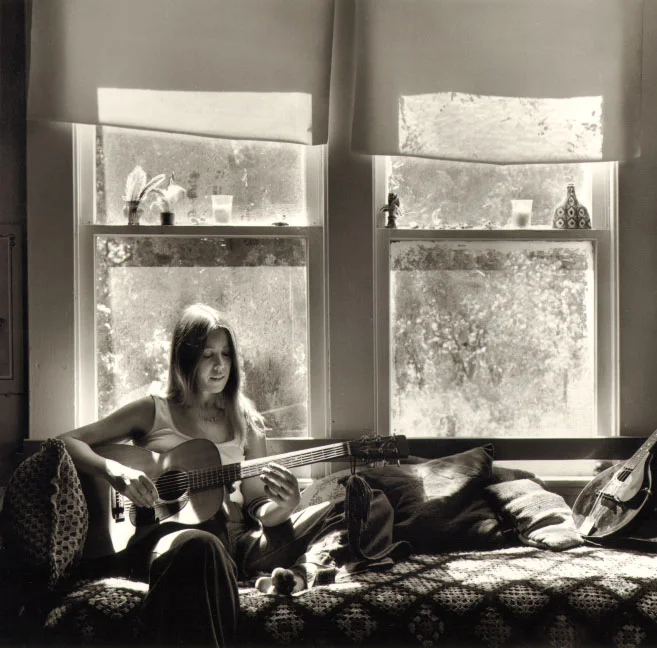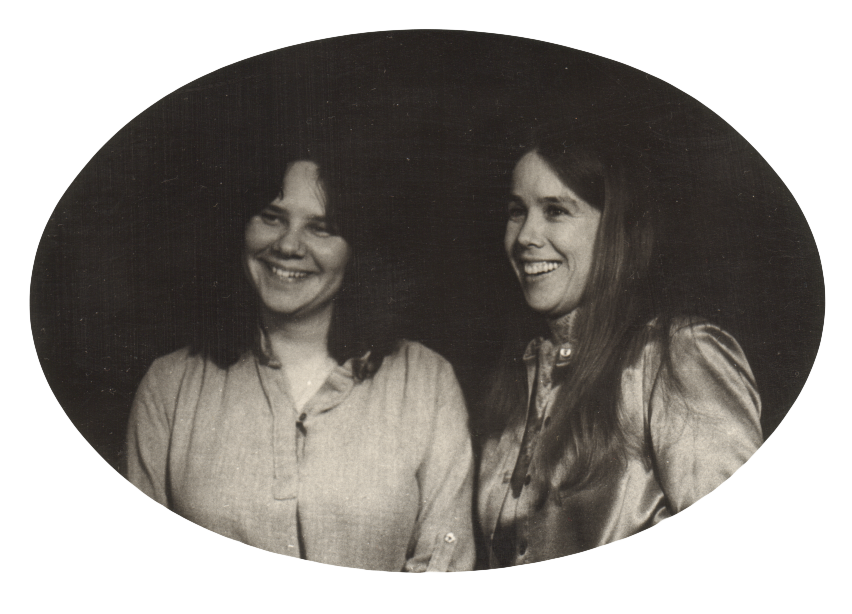Kate Wolf Biography
Kate Wolf Biography
by Max Wolf and Jamie Keller, from the Kate Wolf Songbook
© 1987 Owl Productions. This document is for personal reading, and may not otherwise be duplicated, forwarded, or reproduced in any form. If you wish to make this information available to others, please pass on our address, or if you have a web page, use a link.
Kate Wolf was born Kathryn Louise Allen in San Francisco on January 27, 1942. Called Katie Lou as a child, her name was shortened to Kathy, and later to Kate. Kate's family moved around and she spent her early childhood in Oregon and Michigan, finally returning home to Berkeley where she went to school from the sixth grade through high school.
When Kate was 19, she met Saul Wolf, a UC Berkeley architecture student. Two years later they were married. Kate and Saul had two children, Max, born in 1964, and Hannah, born in 1967. As a child, Kate was always thinking of music, and she began her musical training at the age of four with piano lessons from her grandmother. She played until she was sixteen, but stopped in high school because she felt shy and self-conscious. Even though she no longer played, Kate was strongly influenced by the music she had heard.
“I have to say that it probably started with the Weavers and led to Rosemary Clooney. I started out with singers that you could hear the words. Then I got into writers. Dylan is a big influence and of course the Beatles happened and folk music was always kind of there in the background. I got interested in folk music out of the Kingston Trio stuff and the Weavers. I wanted to know more about it, and started going to libraries. Then I discovered the Carter family. When I got into country music radio, I started to discover Merle Haggard and Lefty Frizell, and people like that. I used to listen to Hank Williams as a kid, so it’s been kind of a progression through honest songs and honest singers; that kind of clarity. I guess it’s that heart that’s out there.”
When she was 27, Kate met some people in Big Sur on the California coast who played music in their living rooms. Kate began playing with them, and hearing their songs, realized that expressing her own thoughts to music seemed the next natural step. She was strongly influenced by her friends Gil "Jellyroll" Turner and George Schroder (The Redtail Hawk) who told her, "Anyone can write a song. Just sit down and sing your conversations."
Kate listened to his words, and within six months she knew she was going to leave San Francisco and her family to pursue a career in music. She and her husband parted amiably, and in 1971 Kate moved to Sonoma County where she lived in her '57 Chevy for six months. She became a weekend mother, and secured a job at the Sebastopol Times Newspaper. She also performed once a week at a local bar and continued her songwriting.
Soon after, her children came to live with her. She became involved in their schooling while continuing to play music once or twice a week in a small restaurant. This went on for a couple of years, and then as Kate put it, "magical things began to happen." Performing became increasingly important to her and she formed her first band, The Wildwood Flower, with Don Coffin whom she later married. The Wildwood Flower played all kinds of community benefits, and Kate became interested in radio. She began a show on KVRE called Uncommon Country, and later moved to KSRO and hosted the Sonoma County Singers Circle.
Kate Wolf with the Wildwood Flower. Left to right: Rick Byars, Blair Hardman, Paul Ellis, Don Coffin, Eddie B. Barlow
Her Sonoma County music shows brought her new recognition, and she was offered funding for an album. With her knowledge of independent labels and the advice of record industry friends, she formed her own record company, Owl Records. Back Roads, her first record, was made for the people of her community, and featured eight of her songs and four by other artists whose works she felt should be recorded. The next year, Kate recorded Lines on the Paper and went on her first tour of California.
With the release of the albums, her audience started coming out to hear the music.
“A big shift occurred where people wanted to hear my songs. It was amazing. It just kind of made its own way. They dragged us out of Sonoma County down into the Bay Area, and then we got airplay, and we started traveling further and further.”
Kate's national touring began in 1977 with trips throughout the Midwest and Northwest. Her long- time friend Bruce "Utah" Phillips helped plan a tour back East where she played concerts and performed at the Philadelphia Folk Festival. Kate's love for Canadian folk music brought her even greater recognition as she performed at the popular festivals in Calgary, Winnepeg, and Vancouver. Closer to home, Kate organized the successful Santa Rosa Folk Festival.
1979 saw a change in the band and in Kate's life. Her separation with Don ended the Wildwood Flower, but saw the addition of Nina Gerber, a very talented guitar and mandolin player who would be her accompanist throughout the rest of Kate's career. Although Kate continued to publish her songs through her own company, Another Sundown Publishing Company, she became too busy to release records on her own label. Her first studio album, Safe at Anchor, was produced and released by Kaleidoscope Records, an established, independent label owned by two friends, Tom Diamant and Jeff Alexson, who had distributed Kate's previous two albums. Kate co-produced this album with Bill Griffin, her long-time friend and musical collaborator.
Nina Gerber, Kate's Long-Time Accompanist
In the Eighties, Kate continued to tour throughout the United States. Although her popularity grew, her concerts never lost their intimacy. Whether she was playing to 500 people in a music hall, or 85 in a coffee house, her audience felt as if she had touched each one of them individually. Her music always had a strong impact on those who heard it. Fans would tell her that she was writing just what they were feeling.
“Sometimes we just can’t find the words, but we all have those same feelings. You feel these things, and you don’t think it’s okay to say them, or you can’t quite get the words, and then it comes, and it’s just this breaking loose: you have a way to say it.”
Kate's fourth album, Close to You, was released in 1981. This record was co-produced by Bill Griffin and Tom Diamant, and, like Safe at Anchor, featured only original compositions. In 1982 Kate married again, this time to Terry Fowler, the owner of a natural foods distribution company. She continued to perform both at concerts and at benefits for groups such as SEVA, No Nukes, and Big Mountain. In 1983 she toured the Southwest with the Academy Award winning documentary film The Four Corners: A National Sacrifice Area?
As her popularity grew, so did critical recognition, and twice she was nominated for best folk singer at the San Francisco Bay Area Music Awards (Bammies). Kate's favorite medium was the stage, and in 1982 and 1983 she realized her desire to record a live album, a two record set entitled Give Yourself to Love. The title song, written for a friend's wedding, became Kate's most popular work, and the record received the "Best Folk Album of 1983" award from NAIRD, The National Association of Independent Record Distributors and Manufacturers.
Late in 1983, following the release of Give Yourself to Love, Kate decided to take a year off from performing. She wanted to rest, evaluate her life, and spend more time with her family.
“The road is wearing me down. I feel my health slipping . . . For twelve years I had been moving fast and furious with my career, so I thought it was time to take a sabbatical.”
During her sabbatical, she worked part-time as a production artist for the Point Reyes Light newspaper. She also studied massage and planned activities at the San Geronimo Community Center in west Marin. Kate did limited performing, but it was not publicized.
Toward the end of the year, Kate realized how important her music was to her and began performing again. She appeared on American Public Radio's A Prairie Home Companion in late 1984, and made frequent trips to the East Coast, especially the Washington D.C. area. After touring the Northwest in early 1985, she began working on her next album, Poet's Heart. Mid-1985 saw her back on A Prairie Home Companion, this time in San Francisco.
In the fall, Kate embarked on her final tour. She spent two weeks on the East Coast playing from Boston to Florida, and then flew to the Midwest and toured through Michigan, Wisconsin and Minnesota.
Following a brief respite at home, she flew to Texas for a taping of Austin City Limits. The show was aired frequently the following year, giving Kate her greatest national exposure. After performing around Texas, Kate came home and played the last leg of her tour through Southern California. Poet's Heart, also co-produced and arranged by Bill Griffin, was released the following January, and was awarded NAIRD's "Best Folk Album of 1986."
Kate Wolf with Bill Griffin
In April, Kate was diagnosed with acute leukemia and underwent chemotherapy at the University of California Medical Center in San Francisco. After recovery and full remission, she returned home and compiled a retrospective of her recordings. As the news of her illness spread, she received support from fans and friends all over the country. Remembering how much Kate had given of herself to the causes and people she believed in, her friends and fellow musicians organized numerous concerts to benefit Kate in her time of need.
In September, Kate reentered the hospital for a bone marrow transplant. She was feeling strong and confident, but complications from the operation destroyed her immune system and she never recovered. The 10-year retrospective album Gold in California was released in January 1987. The following spring, Kate Wolf became the first musician inducted into the NAIRD Independent Music Hall of Fame.
“I live for a sense of a feeling of purposefulness in this world, you know, that I could stop my life at any point and feel that my life has been worthwhile; that the people I’ve loved and my children have all reached a point where their lives are now going to come to fruit. And as far as something I live by, it’s to try to be as alive as possible and feel free to make my mistakes and try to be as honest as I can with myself.”
This biography appears in the Kate Wolf Songbook.
Songs volume 1.
• 57 Songs
• 60 Photos
• 148 Pages
• Comb Binding
• Music for Guitar
• Foreword by Bruce "Utah" Phillips
First published in 1987, this songbook contains words and music to all of Kate's original songs recorded on her first seven albums. Also featured are 60 photos from Kate's musical life, a wonderful piece about Kate written by her long-time friend and co-musician Bruce "Utah" Phillips, a lengthy biography and a complete discography.






